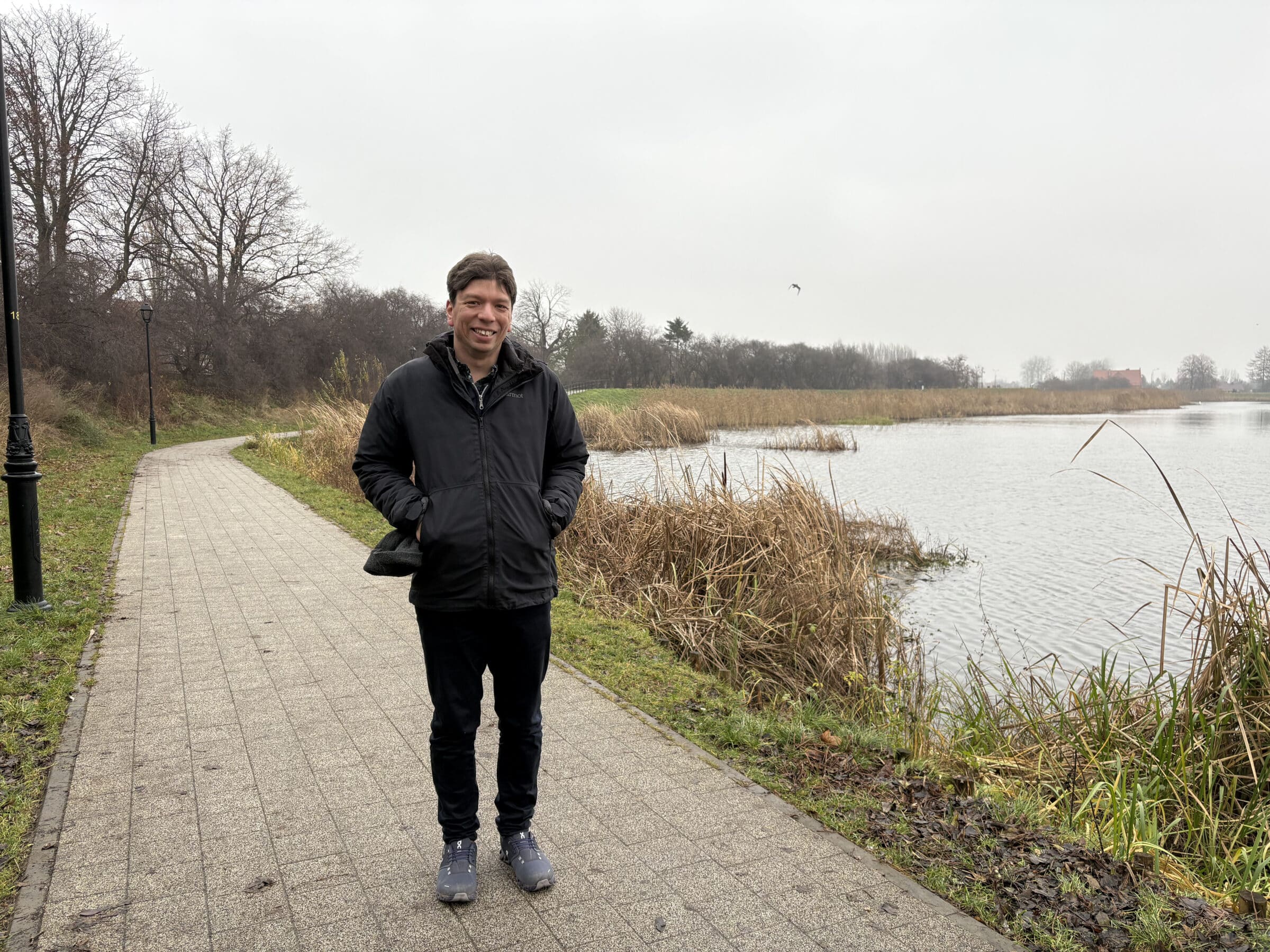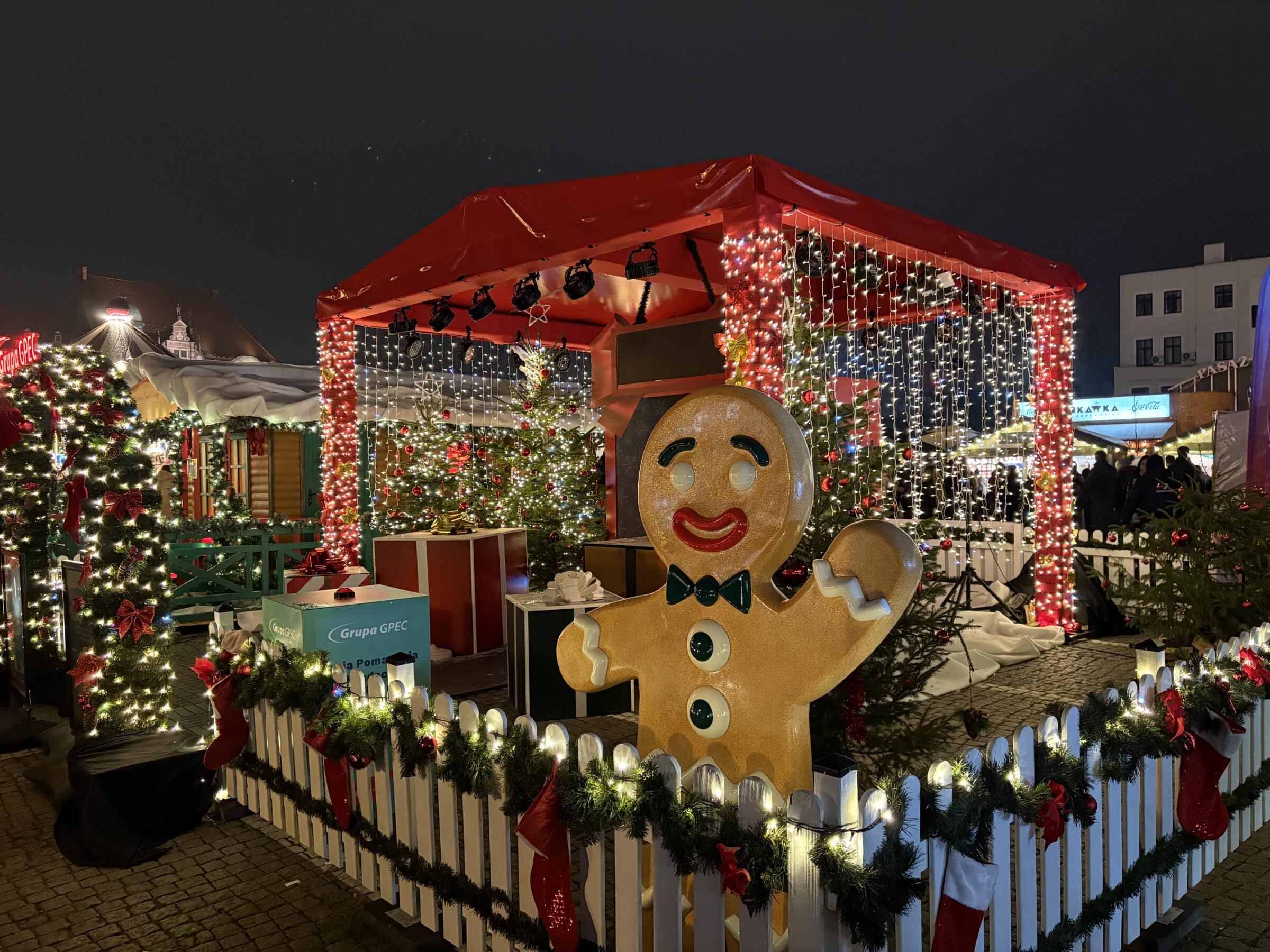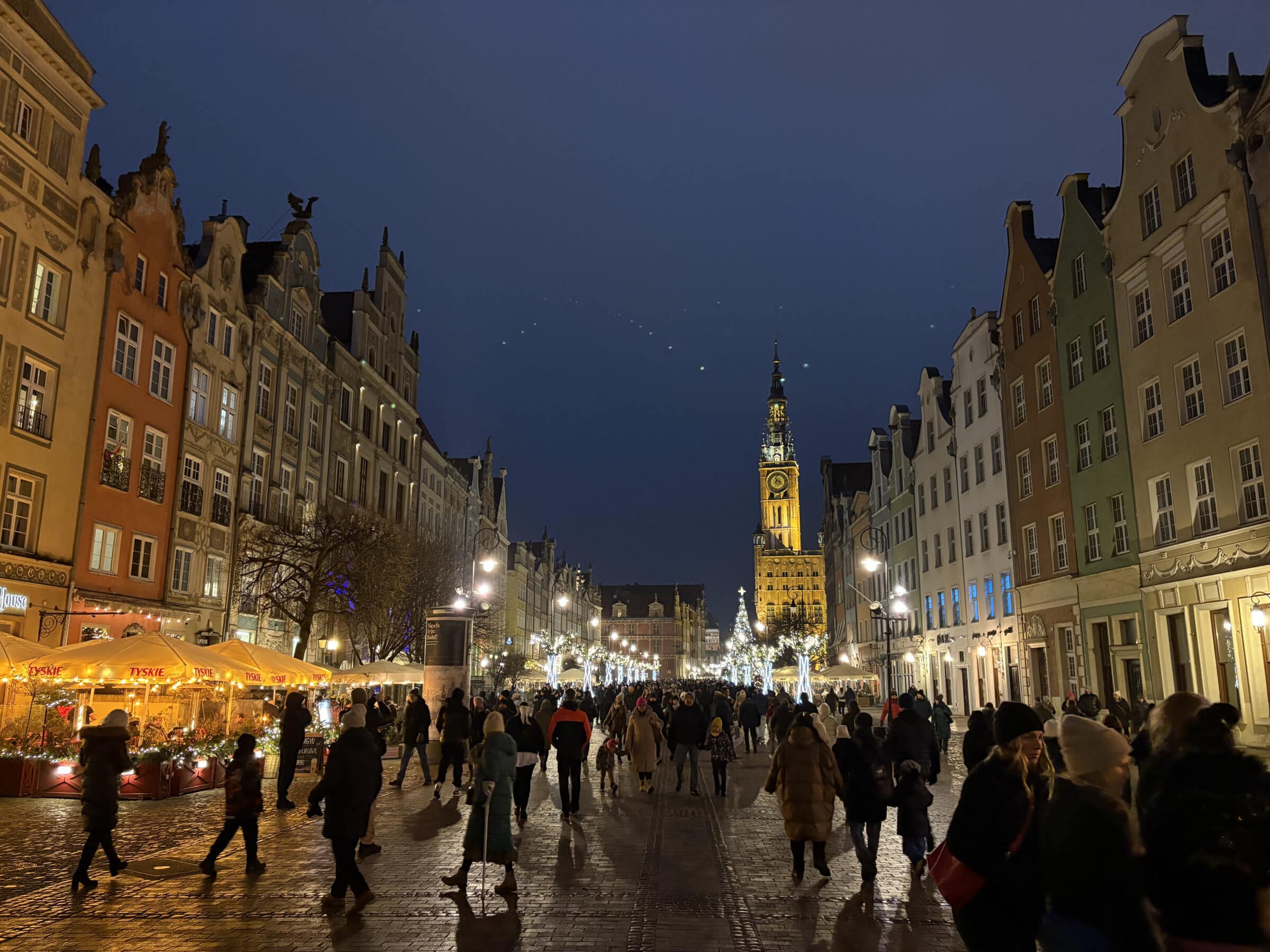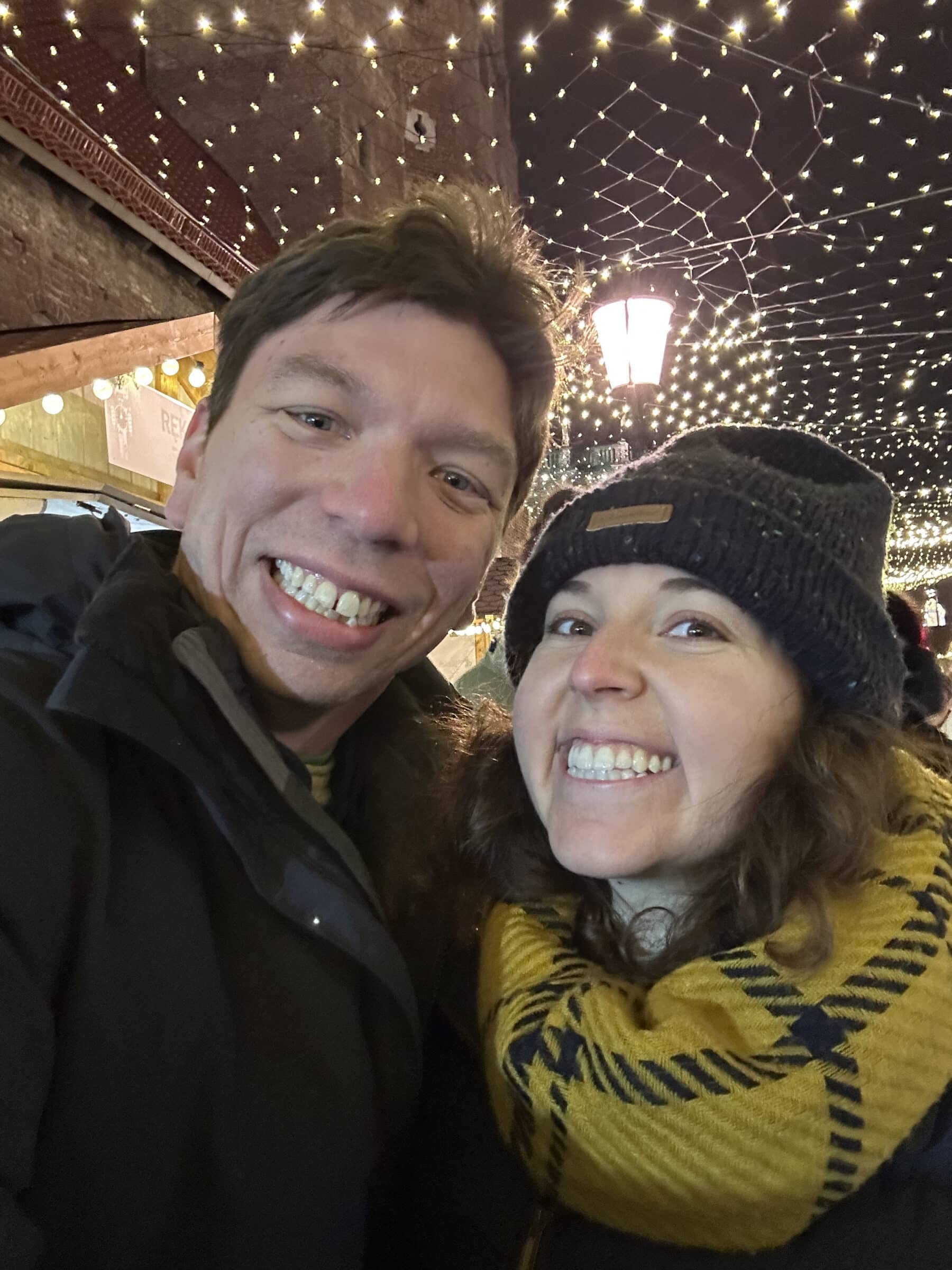Picture the scene. It’s Wednesday evening. Randi and I are sitting on the sofa together under the warm glow of the Christmas tree lights. The night before we were both out at work-related Christmas parties; in my case, a big bash at Freemasons’ Hall organised by Fora (our shared office space provider) and DJed by Annie Mac. Surreptitiously, I’m trying to organise a surprise weekend break for January as a Christmas gift, but I can see in Randi’s eyes that she’s hungry for one thing… a Christmas market, ASAP.
Soon, I’m accelerating my plans into an emergency Christmas trip that very weekend to… *rolls European getaway dice*… Gdańsk!
I’ve always been very curious to visit Gdańsk. Today it’s part of Poland – as it has been many times before in history – but after being invaded by Prussia in 1793, and subsequently becoming part of Germany, Gdańsk (or ‘Danzig’, in German) later spent a remarkable period between 1920 and 1939 as a rare remaining example of a European city state: the Free City of Danzig. My family has a lot of connection with Gdańsk during this period; my great-grandmother was born there. Of course, the reason this independence ended in 1939 was thanks to Nazi invasion, and the entire Jewish population – including my family – either escaped in time or were wiped out. The same is true of many non-Jewish Polish families, and as a result the modern city of Gdańsk, which was almost entirely physically destroyed by 1945, is very much a post-war reconstruction in terms of both its buildings and its people. Still, even though all this means I was never going to find a plaque commemorating my great-grandmother on a wall, you can see how I was primed for a lot of historical resonances.
Our late-night flight from Luton airport was trouble-free, despite being a bit of a trek to get there, but since the moment of booking I’d harboured doubts about whether we really had a room at the Hotel Gdańsk Boutique and when we finally arrived at 1.30am, the subsequent ten minutes of the receptionist’s hardcore keyboard tapping (interrupted only by “can I see your reservation again?”) only confounded my suspicions. Nevertheless, we waited patiently and were eventually rewarded when he finally looked up and handed over the room keys to a much, much bigger room than the one I had booked. Relieved, we hurried to bed before he could change his mind.



Randi also has Polish ancestry, and the next morning she began to experience a growing love for her long-lost motherland when she discovered that the breakfast buffet included both pickles and fish. Having both stuffed ourselves, we walked off our breakfasts on a nature path along one of the branches of the river before turning towards the Old Town for our first foray into the Christmas Fair. Gdańsk is very proud of winning the Best Christmas Market in Europe award for 2025, and if it was ever a ‘hidden gem’ type of place it’s certainly not now! The market is absolutely packed with people, but there are also tons of stalls and we barely had to queue for our latke lunch. (They had a different name, but same thing.) We also tried the delicious little Oscypek dumplings served with cranberry sauce which – I later learnt from Klaudia! – are filled with sheep cheese. Another win for Gdańsk.
You’ll be glad to hear that we took a break from eating in exchange for a two-hour afternoon walking tour, which did get a little chilly as the sun went down. I could have done with a little more historical context from the guide as he was pointing things out, but he redeemed himself at the end with a useful overview of Gdańsk’s history combined with an impassioned defence of Polish democracy against both Putin and the native Law and Justice party. It packs a punch when you’re standing in a courtyard where one of the first battles of the Second World War took place (the Defence of the Post Office); afterwards, the captured Polish prisoners were executed by firing squad.
It is worth saying that, just as in Warsaw, the architecture of the Old Town is truly extraordinary. You’re walking around a medieval city – cobbled streets, protected from cars, flanked on either side by beautiful painted buildings – and yet almost the entire thing has been resurrected from rubble in the 1950s and 60s. As a British person, Poland’s success at recapturing the beauty of its pre-war architecture makes me so envious in comparison to some of the ‘modernisation’ which took place in the UK around the same time. Why?!
Also – fun bonus Gdańsk fact – the physicist Daniel Fahrenheit was also born here, inventor of the historic also-ran Fahrenheit temperature scale, and to commemorate him they still broadcast the weather forecast in Farenheit here… for one day a year. (Note to the US: this is an appropriately limited usage of the Fahrenheit scale.)

After nipping back to our hotel to warm up, we dined on pierogi and salmon (although it turns out that lard is a step too far for Randi) before returning to the Christmas market for a spot of Secret Santering, dessert and a spin on the ‘Spinning Barrels’ fairground ride on which (a) we were definitely the oldest people not accompanied by any children, (b) Randi wasn’t certain if she was going to make it without throwing up or not. (But she didn’t!) Finally, we returned to our hotel to redeem our free beers from the inhouse brewery (see, there’s a reason they were actually fully booked) and enjoyed the live music before bed.



If I claimed we didn’t spend a hearty chunk of Sunday morning down at the breakfast buffet, I’d be lying. (I mean, c’mon, they had honey from the honeycomb.) But then we marched up to the Góra Gradowa hilltop lookout, through the gorgeous Gdańsk Główny railway station and onto the museum which made it to the top of the museum wishlist: the European Solidarity Centre. This was a close call – yes, the other museums were very tempting! – but here you’re spoiled for choice, as on top of everything else Gdańsk was also the birthplace of the Solidarity trade union in the 1980s. This movement led civil resistance against the Soviet-aligned state, precipitating the imposition of martial law in 1981 in Poland and ultimately contributing to the remarkably peaceful downfall of Communist rule. So, of course we had to see this.
Plus, on the walk there we stumbled across a near-infinite stream of motorised Santas to boot…


I won’t recap the entire history of the Polish trade union movement (stifle your disappointment, please) but suffice to say the exhibition was very immersive, and you could really feel the pride not just in the movement’s ultimate success but in how the transition to democracy unfolded in Poland. As Randi noted, it gave us both a new perspective on how painful the democratic backsliding of the last few years must have been for those who opposed the Law and Justice government. The 1980s was never the period of history I had in mind when visiting Gdańsk – my family were long gone by then – but learning more about this era was an unexpected bonus of our trip.




With our emergency Christmas Market mission achieved, we flew home on Sunday night feeling very satisfied and festive. Over the following week, Randi treated me to dinner in Strangers’ Dining Room at the Houses of Parliament (while the abolition of the last hereditary peers was debated down the hallway). The following night we hopped over to Queen’s Park to see Randi’s colleague Dan play a gig at Worldly Wicked & Wise, which in my day (!) was a trinket-filled gift shop but is now a minimalist art gallery with space for a band to play. This was a super-fun night, my favourite song being the adorably silly cover In Spite of Ourselves, which gives you a sense of the vibe.
Finally – and to complete the circle of my last post being drafted on the Friday night train to Edinburgh – this weekend we were back in Scotland! Many thanks to Katie and James for hosting us and also for Katie’s stellar gingerbread men, which were quickly devoured when we all made it over to Kirsty and Roger’s on Saturday night for a really wonderful evening together. We also met Katie and James’s friend Dan over brunch, who patiently answered my dumb gardening questions without rolling his eyes, and later shared some great growing facts with us at the Royal Edinburgh Hospital’s Community Gardens.
In addition, Katie and I completed not one but two classic Doctor Who stories on this trip: 1987’s Paradise Towers and 1964’s Planet of Giants. The former is the first classic story I’ve ever seen with Mel as the companion – a gap I was keen to fill after her triumphant return in the most recent series. It’s safe to say the writing of this character has improved. Poor Mel: back in the day, more than half of respondents to a BBC audience research survey wished she’d been eaten by the cannibalistic couple in this story! Cannibals aside, Paradise Towers is partly a satire about brutalist housing block disasters. I really should love it, but it made me somewhat depressed, especially since I can all too vividly imagine the Twentieth Century Society fundraising to support the Great Architect Kroagnon’s legal defence fund. In contrast, Planet of Giants is more whimsical and fun: the Doctor and his (original) companions are accidentally shrunk down to be very small, and have to escape terrors such as ‘cat’, ‘matchbox’ and ‘plughole’. What more could you ask for?
















